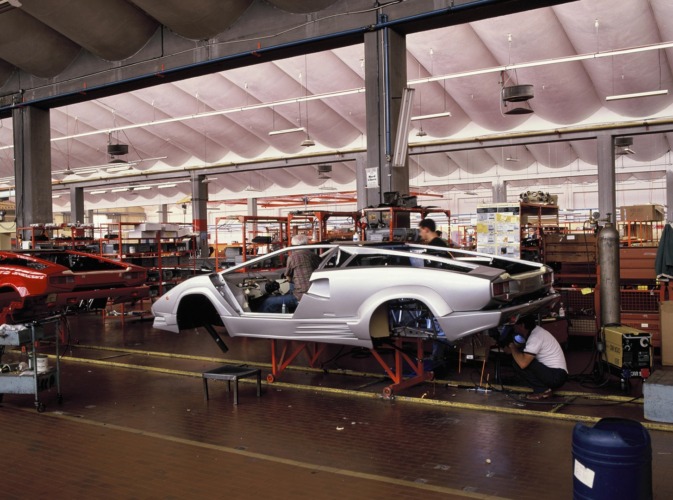
In March 1974, Lamborghini began mass production of the Countach at its factory in Sant’Agata Bolognese, launching a model that would become legendary and remain in production for 16 years. The Countach was the first Lamborghini with bodywork made entirely in-house, where skilled craftsmen hand-shaped the panels.
It was also the first model to have its interiors produced by the Lamborghini Upholstery Department, marking the start of a tradition that continues 50 years later. To celebrate this milestone, Lamborghini recently brought the very first Countach LP 400 back to the production line where it was originally built, now also producing the Lamborghini Revuelto, for a special past-and-present photo shoot. Additionally, Lamborghini has released exclusive archive images of the Countach production line.
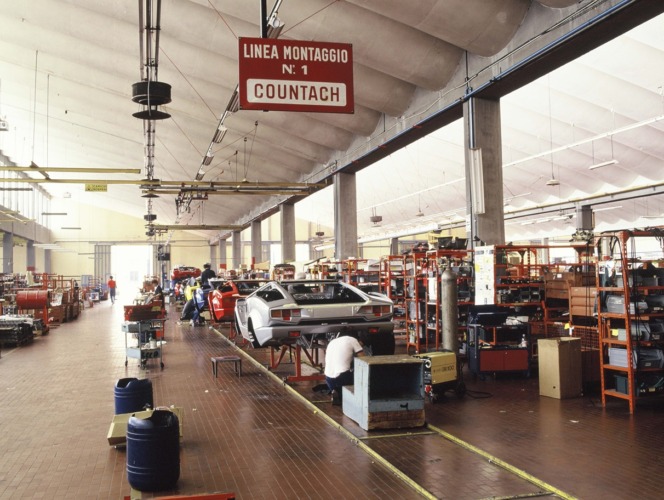
“We are proud to still be producing our super sports car models in the place where the Countach was created,” said Ranieri Niccoli, Lamborghini’s Chief Manufacturing Officer. “Production has radically changed since then, with significant transformations from the Countach to today’s models.
While modern production is vastly different from 1974, it retains the best aspects, combining the craftsmanship of our workers with cutting-edge technology. This blend of tradition and innovation is what we call Manifattura Lamborghini Next Level. The attention to detail remains the common thread between the production of the Countach and our cars today.”
The Evolution of the Countach
The Lamborghini Countach LP 500 was unveiled at the Geneva Motor Show on March 11, 1971, as a concept car. Its overwhelming success led to the decision to make it a production model, resulting in the Countach LP 400 after three years of intense development and road testing.
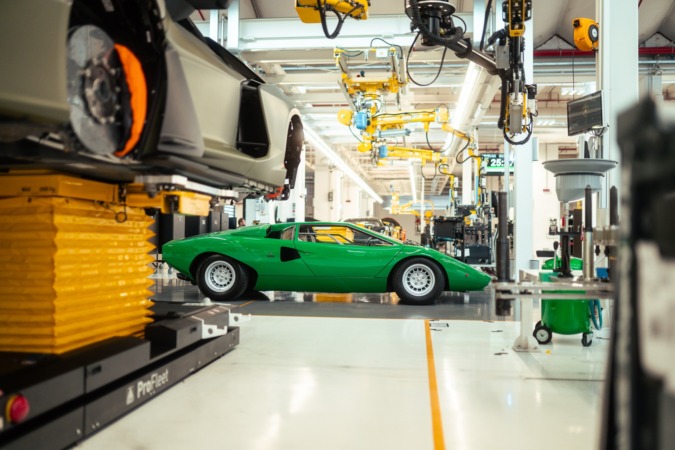
During this time, Lamborghini was also creating the production line at Sant’Agata Bolognese, where the Countach would be built. This move was revolutionary for Lamborghini, as it was the first time the company produced its bodywork in-house. Previously, Lamborghini outsourced the bodywork to external coachbuilders, which was then assembled with the frame and mechanical components at Sant’Agata Bolognese. Bringing bodywork production in-house marked a significant step in the company’s growth.
The No.1 Countach Assembly Line
The original Lamborghini factory, completed in 1966, covered 12,000 m² and included production areas, offices, testing rooms, and a service workshop. It featured two production lines: one for engines and mechanical parts, and the other for car assembly. In 1968, Lamborghini expanded the factory by adding three new industrial buildings, increasing the covered area by 3,500 m².
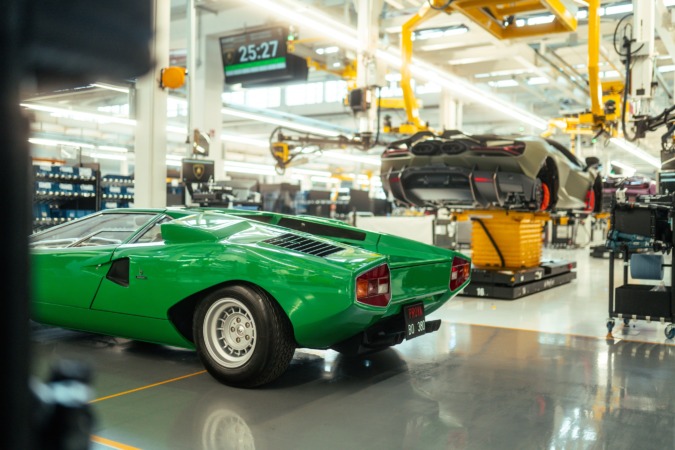
Today, the factory spans 346,000 m², but the area where the Countach was assembled, known as the No.1 Countach Assembly Line, remains the same and now produces the Revuelto, Lamborghini’s new 12-cylinder plug-in hybrid car. During the Countach era, the assembly line was simple and small-scale, with all operations carried out manually. Bodywork panels were hand-beaten, checked on a wooden template, and then welded together and adjusted on the car body mold. Each part, produced and assembled by hand, was slightly different, so final adjustments were crucial.
The raw aluminum body was then combined with the frame, and the entire unit, placed on an industrial trolley, moved between assembly stations where various mechanical parts were installed.
The Countach was also the first model to involve Lamborghini’s Upholstery Department, which initially worked with external suppliers for interiors but eventually became completely autonomous. Today, the production line is more organized, efficient, and ergonomic, with carbon fiber replacing aluminum as the primary material. However, the passion and care with which the operators build new cars remain unchanged.
Continuity Between the Countach and Revuelto
A span of 50 years separates the Countach and the Revuelto, and production volumes have increased significantly. Over its 16-year production run, 1,999 Countach units were built; the Diablo, produced for 11 years, reached 2,903 units; the Murciélago, produced for nine years, totaled 4,000 cars; and the Aventador, produced for 11 years, exceeded 11,000 units.
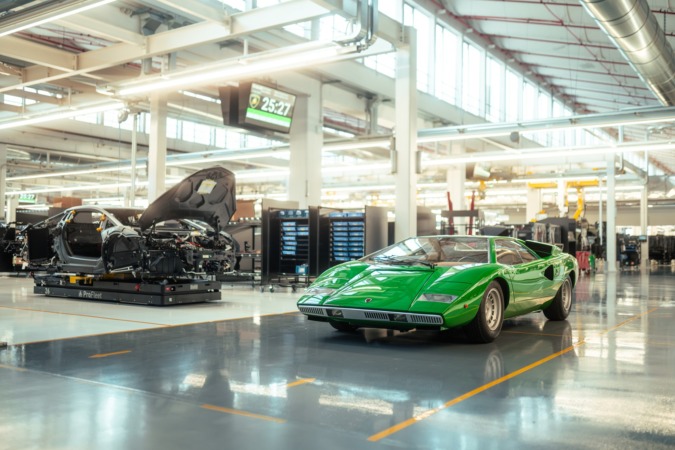
Despite these differences, the Countach and Revuelto share many features. Both have a 12-cylinder rear engine in a longitudinal position, though the Revuelto also includes a battery pack, which required relocating the gearbox behind the V12 engine. The driving setup remains the same, as do the iconic “Scissor” doors, first introduced with the Countach and now a signature feature of Lamborghini V12 models.
Additionally, the stylistic features, which evolved from the Countach to the Diablo, Murciélago, and Aventador, maintain a visual continuity, particularly in the subtle line running between the front fender and cockpit roof, ending with the rear spoiler, known as the “Countach line.”
All the Countach Models
The first version of the Countach, the LP 400 (1974-1978), saw 152 units produced and featured fenders without extensions and a roof with a central recess for the rearview mirror, earning it the nickname “Periscopio.”
The LP 400 S (1978-1982), with 235 units, was directly derived from a special LP 400 commissioned by Canadian enthusiast Walter Wolf. The LP 400 S introduced Pirelli low-profile tires, wheel arch extensions, “phone dial” wheels, and a front aerodynamic appendage, setting the design trend for the following decade. The 5000 S (1982-1984), with 323 units, featured a V12 engine with an increased displacement of 4.8 liters and minor aesthetic changes.
The Countach Quattrovalvole (1985-1988), with 631 units, was visually distinguished by a “hump” on the hood to accommodate the 5.2-liter engine, which featured a 4-valve timing system per cylinder.
The Countach 25th Anniversary (1988-1990), with 658 units, celebrated Lamborghini’s 25th anniversary and included a complete overhaul of the Countach’s aerodynamic appendages. The rear fender air intakes and some panels, such as those on the hoods, were made of carbon fiber for the first time. It’s worth noting that the commercial success of the Countach grew over time, with the last two versions being produced in the greatest numbers, thanks to type-approval for the American market.
During its time on the market, the Countach became a cultural icon, adorning the walls of a generation and featuring in numerous films. It enabled Lamborghini to remain competitive from the mid-1970s until 1990, cementing its legendary status.
Text and Photos: Media Kit















